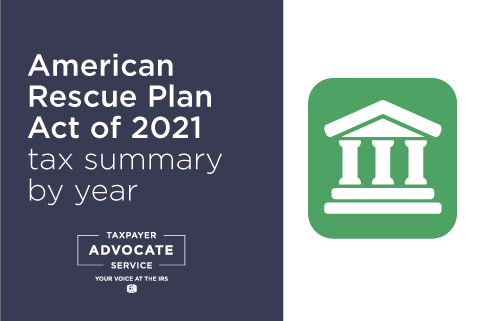The IRS is reviewing implementation plans for the newly enacted American Rescue Plan Act of 2021. The IRS will provide official guidance, processes and procedures, and forms and instructions, as applicable, as soon as possible. We encourage you to continuously check IRS.gov for the latest guidance and updates as they are released.
The following information is a simplified summary of some of the tax provisions that affect the majority of individual taxpayers, by tax year. This list is not all inclusive and is not intended to be used as official guidance. Instead it is intended as a preliminary reference to determine which of these specific individual tax-related provisions are effective for specific tax years. Unless otherwise specified, section references are to the applicable sections of the American Rescue Plan Act of 2021.
Tax Year 2020 – These provisions apply to taxable years beginning after December 31, 2019.
- Unemployment compensation – Sec. 9042 allows an exclusion from gross income of up to $10,200 in unemployment compensation, if the adjusted gross income of the taxpayer is less than $150,000. See IRS Statement – American Rescue Plan Act of 2021 and watch for further guidance.
- For those who received unemployment compensation last year and have already filed their 2020 tax return, IRS anticipates that they will be able to assist unemployment recipient taxpayers to take advantage of the exclusion without additional action on the part of taxpayers, with some exceptions. See IRS to recalculate taxes on unemployment benefits; refunds to start in May. So there is no need for taxpayers to file an amended return unless the calculations make the you newly eligible for additional federal credits and deductions not already included on the original tax return. See the example in the News Release.
- For those who received unemployment compensation last year, follow the IRS instructions on the New Exclusion of up to $10,200 of Unemployment Compensation page. Those who have already filed do not need to file an amended return; as the IRS instructions provide, the IRS will refigure the taxes to make the adjustment. For additional information, go to About Form 1040 to get the latest information about Form 1040, Instructions for Form 1040,and Schedule.
- Premium Tax Credit – Sec. 9662 removes the requirement that excess advance payments are treated as an additional tax liability on the individual’s income tax return for the taxable year. The provision applies to taxpayers who file a 2020 income tax return and reconcile any advance payment of the credit.
Tax Year 2021 – Except where provided, these provisions apply to taxable years beginning after December 31, 2020.
- Student Loans – Sec. 9675 excludes from gross income in taxable years 2021 through 2025 amounts related to the discharge of certain student loan debt, applicable to discharges of loans after December 31, 2020.
Again, please continue to monitor the IRS Coronavirus Tax Relief page, IRS Guidance page and applicable tax topic pages (e.g., Child Tax Credit, Earned Income Credit, etc.) for new and updated information related to the American Rescue Plan Act of 2021.

